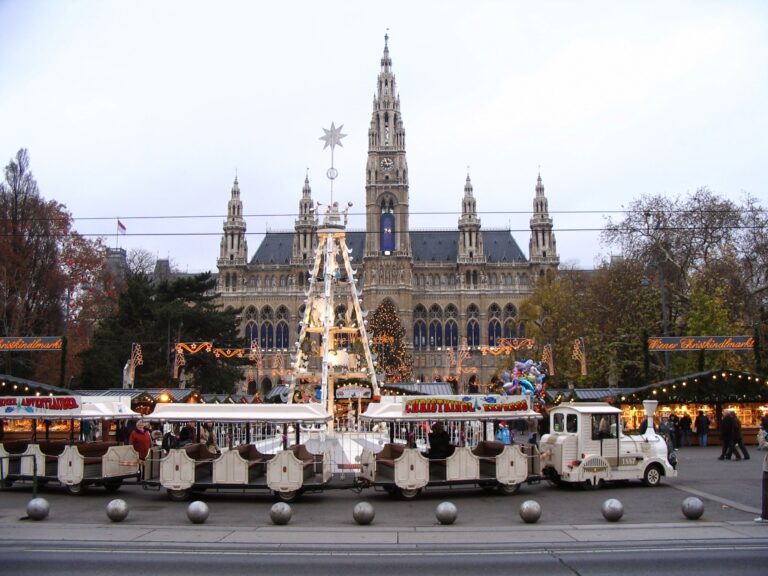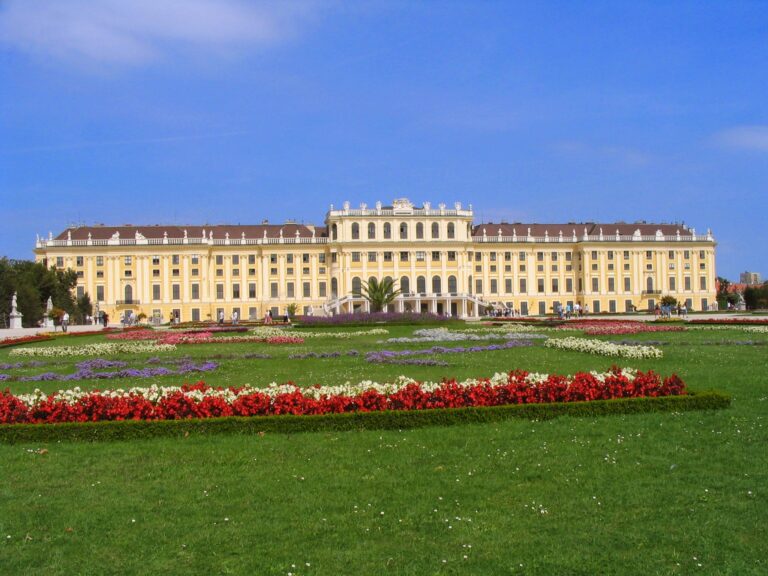Prater, Vienna International center
The Greek Church – This church was built in the 19th century and completely remodeled in Byzantine style in 1858 after designs by Theophil Hansens. Postsparkassenamt – Constructed by Otto Wagner between 1904 and 1906 in the matter-of-fact style of the Secession. Urania – The “Wiener Urania” is an “Institute of Popular Education” that was dedicated to lectures for popularizing science. Kirche am Steinhof – This church is considered Otto Wagner’s most mon the monumental work. It was built in Art Nouveau style in 1904 as the church of the mental hospital. Prater – This traditional Viennese amusement park is highly popular in summer. Formerly the area was accessible only for the imperial family and was opened to the general public by Emperor Joseph II in 1766.
VIENNA INTERNATIONAL CENTRE – Completed in 1979 for the UN organizations already residing in Vienna. The Vienna International Centre has extraterritorial status and was financed by the Republic of Austria and the City of Vienna. Donauturm – Next to the Vienna International Centre are the 247-acre Danube Park ( Donaupark ) built on the occasion of the 1964 Vienna International Horticultural Exposition and the 827-foot high Danube Tower. Islamic Centre – Hubertusdamm 17-19. The area is owned by 8 Islamic states
Petersplatz, Altes Rathaus, Hoher Markt
There are numerous works of art inside St. Peter’s Church.
Platz am Hof – Here was the residence of the Babengerg Duke Heinrich Jasomirgott, built in 1155.
Judenplatz – Here were the Jewish school, the hospital, the rabbi’s house, the synagogue, and the bathhouse. The monument in the Square of the Jews is to the poet Gotthold Ephraim Lessing and recalls his work ” Nathan der Weise” in which he argues for religious unity.
Altes Rathaus – The courtyard is particularly lovely as are also the reliefs on the ceiling of the Council chamber and the Baroque facade with its imposing porch on Wipplingerstrasse.
Maria am Gestade – The Gothic pierced spire is particularly remarkable.
Hoher Markt – Together with the Berghof, St. Rupert’s church, and the Kienmarkt, this square forms Vienna’s oldest part. The ” Anker ” Clock created by the painter Franz von Matsch is also worth seeing. The time is indicated by 12 historic figures. The Joseph’s Fountain ( Josefsbrunnen ) showing the wedding of Joseph’s and Mery (center of the square ) was built in 1732. Synagogue – This synagogue at no. 4 Seitenstettengasse was the only one to escape burning on the ” Night of the Glasses ” in November 1938.
Ruprechtskirche – Vienna’s oldest church; founded around 740, Romanesque style with 2 Gothic annexes.
Vienna Inernational Airport
Located southeast of the city center and accessible via City Airport Train within 16 minutes from the City Air Terminal located near St Stephan’s Cathedral on Landstrasse. the round trip fare is 16.- Euro. Taxis are relatively speedy and good value, but the traffic can be chaotic and slow.
Schweizerhof, Neuer Markt, Albertina
Schweizerhof – It is entered through the Swiss Gate (the oldest part of the Imperial Palace; 13th century ). From there, a pillared staircase leads up to the Treasures. Michaelerplatz – From here you enter the Imperial Palace through st. Michael’s Gate ( Michaelertor ).
Michaeler-Kirche – In 1626 the church passed to the Barnabites and a cloister and garth were added.
Josefplatz – From the architectural point of view one of Vienna’s most beautiful squares with the memorial to Emperor Francis Joseph in its center. The Library wings with several ballrooms complete the building. From Josefplatz you also enter the Spanish Riding School ( Spanische Hofreitschule ) another buildung by Fischer von Erlach.
Neuer Markt – This second market square of ancient Vienna has a very eventful history. During the war, it was severely damaged but the ” Providence Fountain ” ( Providentia ), also called Donner Fountain ( Donner Brunnen ), was saved.
Kapuzinerkirche / Kaisergruft – It is situated on the Neuer Markt and was consecrated in 1632.
Albertina – It is the world’s largest collection of graphic arts. Graben – In 1679 the Trinity Column was erected by order of Emperor Leopold l as a sign of gratefulness when the black plague subsided.
Burgtheater, Volksgarten, Hofburg
Burgtheater – Designed by Gottfried Semper and Carl Hasenauer and built as Imperial Court Theatre between 1874 and 1888. After severe damages during the war reopened in 1955.
Volksgarten – Laid out in the place of the former Palace bastion; accessible to the public since 1823.
Burgtor – This Gate was erected in 1821 – 24, with older Doric columns. It is decorated with Francis l Latin motto: ” Justice is the Foundation of Kingdoms”.
Burggarten – Formerly imperial gardens; accessible to the public since 1919; many memorials such as to Wolfgang Amadeus Mozart, Emperor Francis l ( Franz Stephan of Lorraine, husband of Maria Theresa ), and Emperor Francis Joseph. At the backside of the Imperial Gardens, there is a palmary.
Neue Hofburg – To this most recent section of the Imperial Palace ( construction works lasted from 1881 to 1913 ) an equivalent building on the opposite side ( area of the Common Gardens ) was planned but due to the disintegration of the Monarchy the project could not be carried out. It now houses the Ethnographic Museum ( Museum fur Volkerkunde ), the Ephesus Museum, the Collection of Arms, and the large reading hall of the National Library.
Messezentrum Wien Neu ( New Vienna Convention & Exibition Center )
A palatial expanse of glass structures took up the Job as Vienna’s Convention and Exhibition center in January 2004 with 60.000 sqm of exhibition space. The easiest way to reach the exhibition center is either with taxi direct from the city center or the airport or via public transport with U-Bahn U1 to Praterstern station, then with Tram 21 to Messeplatz station, or with Bus 11A to Elderschplatz.
Parlament, Rathaus, Universitet
Kunsthistorisches Museum – To the left of the Maria Theresa memorial. Built by Gottfried Semper and Carl Hasenauer from 1872 to 1891 in the style of the Italian Renaissance. Egyptian-Oriental collection, classical antiquity collection, collection of coins and medals. Outstanding is the collection of paintings by Duerer, Rubens, Titian, and Bruegel.
Parlament – Designed by Theopil Hansen and built from 1874 to 1883 in the style of the Greek Revival. Until 1918 seat of the representatives of the Austrian half of the dual Austro-Hungarian Monarchy. Today, the seat of the National Council and the Federal Council. Rathaus – The wide Neogothic construction with certain elements in Renaissance style how houses the City Council Cham-ber, the Municipal Library, and the Archives of the City of Vienna.
Universitet – Designed by Heinrich Ferstel and built from 1873 to 1883 in the style of the Italian Renaissance. The oldest university in German-speaking Europe. Votivkirche – Designed by Heinrich Ferstel and built in the style of the French Neo-Gothic cathedrals from 1856 to 1879 in commemoration of the unsuccessful attempt to assassinate Emperor Francais Joseph I. Schottenkirche and Schottenkloster – Between 1826 and 1832 Joseph Kornhaeusl built a Neoclassical convent in place of a Gothic cloister, and replaced the outbuildings with a large three-story apartment block.
Maria Theresien-Denkmal – Designed by Carl it was made in 1874-88 by Kaspar von Zumbusch. The figures are in bronze. Maria Theresa was a very popular monarch, and many fundamental reforms were introduced during her reign, such as example the simplification of the feudal state system, the abolition of torture, the introduction of compulsory schooling, the creation of a Civil Service, etc. The Universities were transferred from the Church and became State Institutions. Maria Theresa also managed to have 16 children during her reign.
Kaertnerstrasse, Stephansdom, Wiener Staatsoper
Kaertnerstrasse joining the Staphansdom with the Opera, the most important and elegant shopping street in the city is now a pedestrian zone. Several historic palaces ( such a Palais Esterhazy and Palais Todesco ) remind one of the historical importance of this stretch of street.
Stephansdom – The construction works of Vienna’s landmark lasted several centuries. You can go up the North Tower by elevator and enjoy a marvelous view of the town. Some of the outstanding parts of the church are: the Lady altar “Maria Poetsch”, the high altar ( lapidation of St. Stephen ), the pulpit by Anton Pilgram chiseled out of 7 blocks of stone, the sepulcher of Emperor Frederick III in the right aisle, in the left aisle the Altarpiece of Wiener Neustadt ( Wiener Neustaedter Altar ) dating back to 1447 and the Tirana Chapel with the tomb of Prince Eugen of Savoy, the organ over the Giant Gate, the small 18th-century Baroque altars at the pillars, the ledgers and the memorial plaques at the side walls commemorating the people buried in the former church cemetery.
Wiener Staatsoper – The Vienna State Opera is ranked as one of the world’s best opera houses. Among its directors were Gustav Mahler, Richard Strauss, Clemens Krauss, Dr. Karl Boehm, Herbert von Karajan and Lorin Maazel. Its present director is Jan Holaender. Here, the famous Vienna Opera Ball takes place every year in the carnival season. The orchestra of the State Opera is called the Vienna Philharmonic Orchestra and is famous all over the world.

